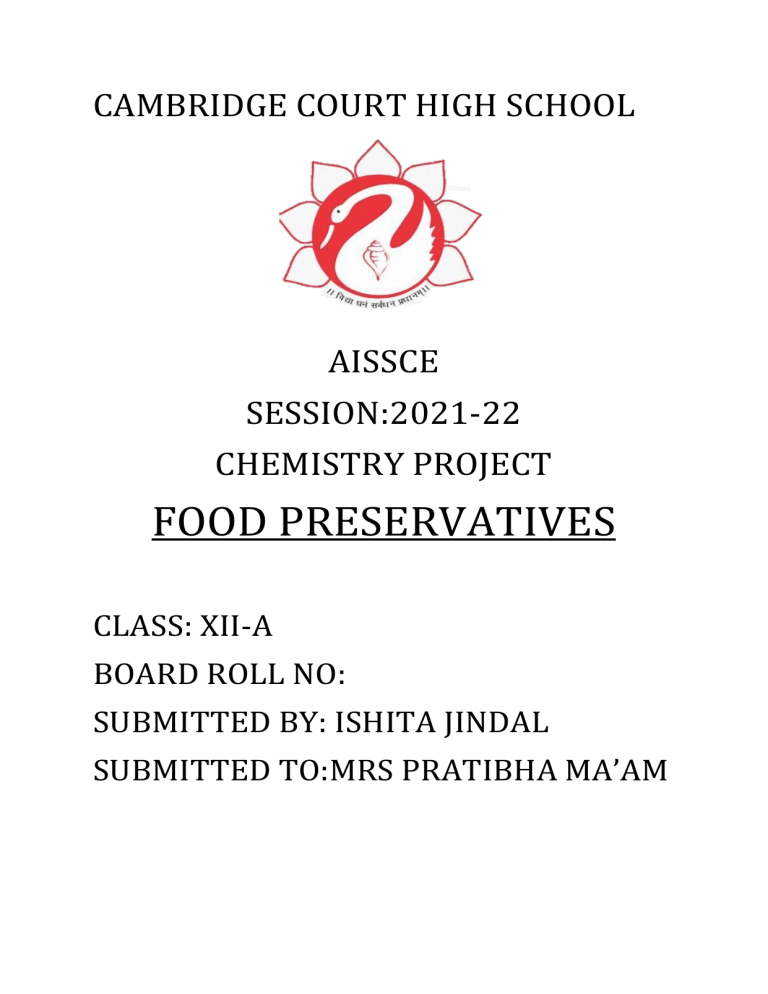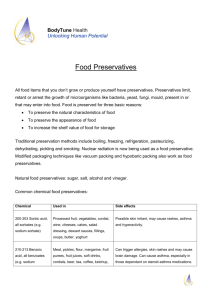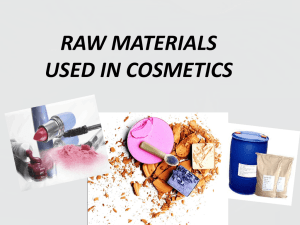
CAMBRIDGE COURT HIGH SCHOOL AISSCE SESSION:2021-22 CHEMISTRY PROJECT FOOD PRESERVATIVES CLASS: XII-A BOARD ROLL NO: SUBMITTED BY: ISHITA JINDAL SUBMITTED TO:MRS PRATIBHA MA’AM ACKNOWLEDGEMENT I would like to express my gratitude to my teacher who gave me the opportunity to do project on FOOD PRESERVATIVES, which also helped me in lot of research and I come to know about so many things. I am really thankful to them. I would also like to thank my parents who gave me guidance and suggestions regarding this project. I would like to thank my friends for their support. Finally, I would like to thank everyone who helped me in completing this project. CERTIFICATE OF AUTHENTICITY This is to certify that ISHITA JINDAL, student of class XII has completed research project on FOOD PRESERVATIVES under the guidance of MRS.PRATHIBHA MA’AM. This project is absolutely genuine and does not indulge in plagiarism of any kind. The references taken in making project have been declared at the end of this project. SIGNATURE (SUBJECT TEACHER) INDEX Contents ❖Introduction ❖Experiment ❖Food Spoilage ❖Harmful food preservative ❖Traditional ways of Preserving food ❖Pros & Cons ❖Uses ❖References Page no. 1 2-4 5 6-7 8 9 10 11 INTRODUCTION • In the present scene, food preserve had become the life of man. Food preservation is important due to more reasons. Some foods as fruit and vegetable are in specific seasons and not others, while other foods are more abundantly available in some season than in others. In certain areas there is more food products, whereas in other places there is an inadequate supply. • Food preservation methods of preparing food so that it can be stored for future use. Because most foods remain edible for only a brief period of time, people since the earliest ages have experimented with methods for successful food preservation. Among the products of early food conservation were cheese and butter, raisins, pemmican, sausage, bacon, and grain. Experiment OBJECTIVE: The purpose of this experiment is to determine what preservatives keep fruit from turning brown the longest. REQUIREMENTS: • • • • • • • • Container Stirrer Fruits (Pureed apple, banana and avocado) Salt Sugar Lemon juice Vegetable oil Avocado pit PROCEDURE: 1. Pureed apple, banana, & avocado (480 mL each) were measured into 6 separate containers (3 trials each). 2. Then 2.5 mL of each preservative (salt, sugar, lemon juice, avocado pit, & vegetable oil) were measured separately into the fruit & stirred. 3. As the control, one container of each fruit did not contain any preservative. 4. The colour of the fruit was measured at similar time periods over the next 2 days using a colour scale. RESULT: • Salt was the best preservative for apples by far. Even 2 weeks after the start of the experiment, the apples did not turn brown. • Lemon juice & salt in bananas slowed the browning a little more than the other preservatives. • For avocados, none of the preservatives slowed the browning. Adding salt to avocados increased the browning even more than with no preservative. • The avocado pit, sugar, oil, & control all gave about the same results for all 3 fruits. CONCLUSION: • When fruit is peeled or cut open, oxidation occurs. Oxygen reacts with the ironcontaining phenols in the fruit. The oxidation forms sort of a rust on the surface of the fruit to cause browning. • Enzymes act as catalysts for the oxidation reaction or speed up the ripening or browning of the fruit. Both physical and chemical methods inhibit oxidation typically by denaturing the enzyme. • My hypothesis that lemon juice is the best preservative was not proven. Because each fruit has different enzymes that act as catalysts to speed up the browning, no one preservative will denature (break down) all the enzymes in all fruits the same. • For example, salt denatures the enzyme in the apple the most probably by removing water from the cells. Without water the enzyme denatures& the apple doesn’t brown. But salt browns the avocado the fastest. So, salt somehow helps the enzyme brown the longest. FOOD SPOILAGE We often see that the food that has been kept out for too long smells foul and looks rotten. It is all because of growing of microorganisms on food. Once the food is spoiled, it cannot be eaten and has to be thrown away. Spoilage is a process in which food items deteriorate to the point in which it is not edible to human. Food spoilage is the process where a food product becomes unsuitable to ingest by the consumer. The cause of such a process is due to many outside factors as a side effect of the type of product it is, as well as how the product is packaged and stored. Bacteria and various fungi are the responsible for spoilage and can create serious consequences for the consumers. But this food spoilage can be stopped by taking suitable preservation steps. Moreover, issues of food spoilage do not necessarily have to do with the quality of the food, but more so with the safety of consuming food. Harmful Food Preservatives Although preservatives food additives are used to keep the food fresh and to stop the bacterial growth. But still there are certain preservatives in food that are harmful if taken in more than the prescribed limits. Certain harmful food preservatives: Butylates ❖ This chemical food preservative is expected to cause ❖ high blood pressure and cholesterol level. ❖ This can affect the kidney and live function. It is found in butter, vegetable oils and margarine. BHA (butylated hydroxyanisole) ❖ BHA is expected to cause the live diseases and cancer. ❖ This food preservative is used to preserve the fresh pork and pork sausages, potato chips, instant chips etc. Caramel ❖It is the colouring agent that causes the vitamin B6 deficiencies, genetic effects and cancer. ❖It is found in candies, bread, brown coloured food and frozen pizza. Traditional And Indigenous Ways of Preserving Food • Kiviak is a traditional wintertime food from Greenland that is made of seabirds preserved in the hollowed-out body of a seal and which are served at feasts or weddings. • North American tribes were the first ones to eat, a mixture of dried meat and tallow. It was adopted as a high energy food by explorers as it is fatandprotein. • Bedouins and other desert populations produce ghee that has a shelf-life and no refrigeration, prepared by boiling butter and removing residue. • Earthen pots served as preservation of boiled food which could remain fresh for several days. The food could be kept in a well aerated store called "Ikumbi". In Andhra Pradesh, India, lemon juice is used as preservative for chutneys, pickles for long journeys. PROS AND CONS ✓ Increase the life of food. ✓ Make food safer to eat by removing toxins. ✓ Enrich food by adding daily nutrition requirements. Preservatives cause allergic reactions in people with asthma. Some preservatives are harmful to children. Some preservatives like sodium nitrates are carcinogenic. USES OF FOOD PRESERVATIVES • Increasing the self-life of foods thus increasing the supply. • Many perishable foods can be preserved for a long time. • Making the seasonal available throughout the year. • Adding variety to the diet. • Stabilizing prices of the food thus reducing food demand. • Improving the nutrition of the population. • Preventing decay or spoilage of food. REFERENCES • WIKIPEDIA • VEDANTU • NCERT BOOK



